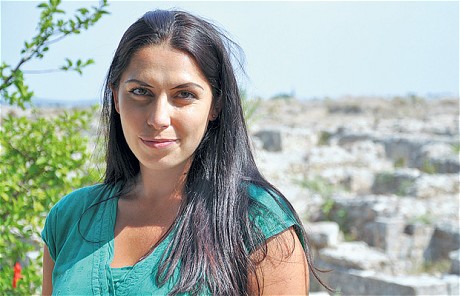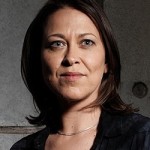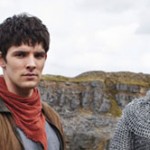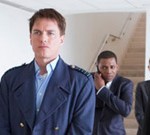 If you’ve not been sucked into BBC Four’s The Killing (which, I think mistakenly, I haven’t) it’s been a bit of a slow old week, telly-wise. Still, it’s important to maintain a balanced diet even when faced with slim pickings, so this week I turn to BBC Two documentary Bible’s Buried Secrets and the return of Cat Deeley-fronted talent show So You Think You Can Dance.
If you’ve not been sucked into BBC Four’s The Killing (which, I think mistakenly, I haven’t) it’s been a bit of a slow old week, telly-wise. Still, it’s important to maintain a balanced diet even when faced with slim pickings, so this week I turn to BBC Two documentary Bible’s Buried Secrets and the return of Cat Deeley-fronted talent show So You Think You Can Dance.
I missed the first episode of BBC Two’s Bible’s Buried Secrets, but it’s clear that presenter Dr Francesca Stavrakopoulou is up for causing a bit of a stir, conspiratorially starting her programme with lines such as “there’s something about this ancient world that the Bible’s not telling us…” “literature with a religious agenda that distorts the past…” and (dun-dun-duuuun) “an idea that rocks the foundation of monotheism to its core.”
In this week’s episode, she met with leading scholars of Jewish, Christian and Muslim faith, all of whom, of course, state that believing in a single God is the fundamental basis of their religion; the thing that sets them apart and something about which there can be no argument. Enter Dr Francesca Stavrakopoulou.
Her thesis is that there are references to polytheism throughout the Old Testament and Hebrew Bible, references which have been buried and ignored. She starts with the struggle to stop early Israelites worshipping the Canaanite weather god Ba’al, and moves onto the Canaanite ‘chief’ God, El, a name which she says was actually used in the Bible for the singular, Judeo-Christian God, suggesting that the two can be and were conflated. She even plucks out phrases from the Bible suggesting that there was a “council” of gods. Dr Francesca saves her big ‘reveal’ until about half an hour in though, gleefully asserting that God had a wife who has been written out of history.
This is very much Dr Francesca’s own lecture, and there are some pretty sweeping statements made on what appears to be rather slight evidence, but if you’re interested in reading the Bible as a literary text, it’s fascinating. Next week, she’s on the hunt for the ‘real’ Garden of Eden.
WWBW on SYTYCD
Rather less cerebrally challenging but still really rather enjoyable was the first episode of the new series of So You Think You Can Dance, the televisual baby of “Nasty” (AKA “not-at-all-nasty”) Nigel Lythgoe.
What sets this apart from other reality TV shows — and particularly those which revel in the audition stages (ITV, I’m looking at you) — is the emphasis on the good over the bad. They did slip into it a couple of times, notably with a guy who was actually after Cat’s job, and a man who’d written a poem for Arlene, but they admirably resisted in the main.
So instead of endless footage of deluded wannabes pleading with the judges, we just get to see lots of really great dancing; tap, lyrical, contemporary, ballet — the sort, in fact, that you just don’t tend to see on TV very often. The last series uncovered several genuine talents, and if the quality of the first episode is anything to go by, this time will be no different.

 Spooks: Series 9, Episode 4 – Dork Review
Spooks: Series 9, Episode 4 – Dork Review Merlin: With All My Heart – Dork Review
Merlin: With All My Heart – Dork Review Misifts: Series 2, Episode 3 – Dork Review
Misifts: Series 2, Episode 3 – Dork Review Torchwood: Miracle Day – Episode 2 – Dork Review
Torchwood: Miracle Day – Episode 2 – Dork Review RSS
RSS
The Garden of Eden has been found in the Rachaiya Basin, Southern Lebanon by exploration geologist and multi disciplined researcher Christian O'Brien CBE, who recorded the facts on this discovery in his book, co-authored with his wife Barbara Joy, the Genius of the Few in 1984.
Up to date translations of Genesis, the Books of Enoch and the crucial Sumerian Kharsag cuneiform records from the Nippur library, re-write our secular history without religious bias.
A raft of supporting evidence is available, which features this site as the source of the domestication of crops and animals (plus technologies) from 9,400 BC, at the start of the Holocene warming, following the Great Younger Dryas cataclysm generated ice age. Together with site survey report and records, photographs, and video presentations, much more is available on our secular history on the Golden Age Project website.
An, the leader of the small advanced group who re-started agriculture and civilised living following this global catastrophe, was later deified as the earliest monotheistic God. Yahweh in fact translates as leader of this group, in Hebrew described as the Elohim. The Qur'an translates as the readings and recitations of An, although the contents were recorded some 9,800 years later.
An's daughter Ninkharsag was the governor of the research establishment based on irrigation agriculture, and later described as the Goddess of Irrigation (or Ceres). Her statue was the central feature in the 200 acre administrative centre of Mari (another name for Ninkharsag) on the Euphrates. On the documentary Dr Francesca came close to this important information and should have done her homework on this crucial subject, which identifies Ninkharsag, wife of Enlil, as the origin of the Mother Goddess, upon whom Ashera was much later based.
Male and female leaders of communities were described as Yahweh and Asherah. Asherah could be wife or consort, and this formed the basis of the equal male and female administrative roles of Mayor and Mayoress, which still survives, but carrying the religious bias or dogma against the role of women.
Our first Laws were the Edicts of An and Enlil (El Shaddai or El Elyon) and our first Encyclopaedia of Astronomy was Enuma An and Enlil, factors which would have been well known and understood by Abraham of Ur.
The origin of Original Sin is set out below by Christian O’Brien from his improved translations of the Book of Enoch in the Genius of the Few.
[SE XIX:l-S PP] After this, the men brought me to the sixth haven, and there I saw seven groups of Angels, very bright and wonderful, with their faces shining brighter than the Sun. They were brilliant, and all dressed alike and looked alike.
Some of these Angels study the movements of the Stars, the Sun and the Moon, and record the peaceful order of the World. Other Angels, there, undertake teaching and give instruction in clear and melodious voices. These are the Archangels, who are promoted over the ordinary Angels. They are responsible for recording (and studying) the fauna and the flora in both the Highlands and the Lowlands.
There are Angels who record the seasons and the years; others who study the rivers and the seas; others who study the fruits of the Lowlands, and the plants and herbs which give nourishment to men and beasts.
And there Angels study Mankind and record the behaviour of men, and how they live.
This record of the sixth place to which Enoch was taken within Eden is the fullest statement that we have, anywhere, of the actual daily activities of the Angels/Anannage in the Settlement of Eden/Kharsag. And the extraordinary conclusion, which we find that we cannot avoid, is that these activities appear to be compatible with the scientific interests of an exploration expedition into unknown country. Its members appear to have been studying every facet of science which such an expedition would require – from geology to botany, and from astronomy to anthropology.
The passage goes even further, and provides a rational explanation for the religious concept of the Recording Angel – and the writing down of the good, and bad, deeds of men. From this account, we can now understand that these angel investigators were only observing Mankind from anthropological, genetic and psychological viewpoints – they were not concerned with 'guilt' or 'original sin: which can now be seen as superimpositions by later, misunderstanding, religious interpreters.
Kramer may be right when he claims that 'History began at Sumer'. But Prehistory, and prehistorical science in particular, began at Kharsag in Eden – and for our knowledge of this, we can thank Enoch and the scribes of Sumer.